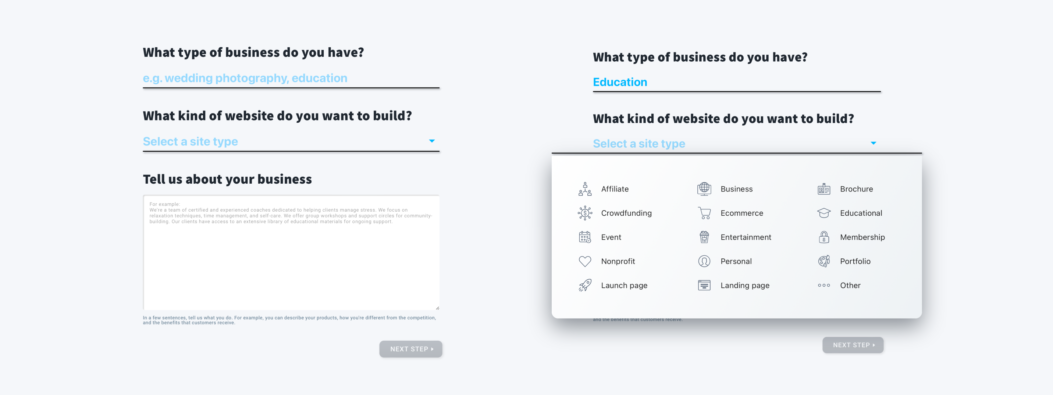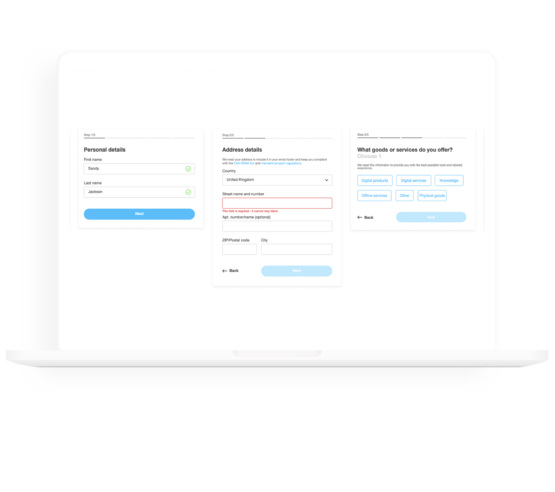Shaping up SaaS solutions
Together with a team of experts I took care of improving product experiences of SaaS solutions such as GetResponse.

Summary of the process
Working on improving existing products often means finding suitable solutions that follow stakeholders’ vision and fit user’s needs. It also means smoothly communicating introduced changes. Therefore, it’s crucial to collaborate closely with a number of teams.

Design process overview
Stakeholders
Whether it’s a meeting, a workshop or a written communication, I involved the stakeholders in the process form the very beginning of the project.
User and industry research
Once a need for a new feature or a modification of an existing one arose, I analysed relevant data available on the topic. I dug into user feedback and checked whether there were any reports that could be useful for the project. If time and budget allowed, I research user needs by organising IDIs with users, or by gethering information from experts.
Benchmarking
Checking other available tools or features is always one of important steps in my process. I enjoy discovering and finding different takes on the issue, so this is very inspiring to me. If there are no comparable tools, I search within a specific field, to gain the understanding of it. I look into advantages and disadvantages in the context of a solution I’m working on.
Apart from external solutions, I also look into the already implemented options and see whether any of them can match what is needed.
Workshops
This stage is a great opportunity to use the already gathered information and share it with people involved in the project. I use this place and time to equalize knowledge and learn more from the experts.
Workshops also give a sense of ownership to people included in the project. Unfourtunately there isn’t always time and budget for this step of the design process.
User personas and scenarios
With all the information I gather on the users, I’m able to build personas (or proto-personas) that help throughout the design process to focus on users’ possible profiles.
User scenarios serve me to structure specific behaviour of the persona in a situation, in which a user could need to use the solution.
User journey map
This is often part of the workshops and is when the solution starts to shape up, often for the first time. Except for defining steps, I use this tool to understand the pain points that user may encounter and find opportunities to turn them into advantages.
The map helps me to better understand the users and their desired experience with the tool. It also works as a method to define priorities and required steps for an MVP.
Flowcharts
This is an important stage, because it’s when I work on the information architecture of the solution. Since flowcharts are a visualisation of the information flow, I believe they provide an excellent opportunity for further step-by-step discussions regarding structure of the solution.
Wireframes
Wireframes are a metamorphosis step in a way. They turn an idea into a tangible outline of the solution.
In many cases I work with the existing components that are part of a design system of a product. However, I still prefer to sketch a few low-fidelity views on paper to work out the first concepts of the elements’ placement and behaviour.

Prototyping
This is usually where previous sketches and architecture structure come alive by becoming interactive.
Early prototypes give a perfect opportunity to conduct first usability tests. I believe that at this point, even corridor tests with people within a working environment can already provide useful feedback. I like to conduct them prior to moving to usability tests with actual users.
User testing
Once the prototype is analysed and includes all the needed amendments, it’s time for tests with users. This crucial part is a reality check for the worked out solution.
Iterating
After the users show how the solutions works for them, it’s time to introduce modifications based on the observations and feedback gathered from them. Depending on the project there may be a few rounds of iterations.


Conclusions
I must say that my previous experience in working as a European administrative and project coordinator gave me precious organisational skills that I implement in any undertaking.
Every project is a new adventure that should be treated individually. However, with a set of rules and a consisten design process, it’s easier to decide upon stages of the project.
I don’t always follow all of the described steps. As I work, I discover different options and possibilities to improve my process and adjust it for the project’s needs. With this in mind, I remain open to discussions and learings from other people.